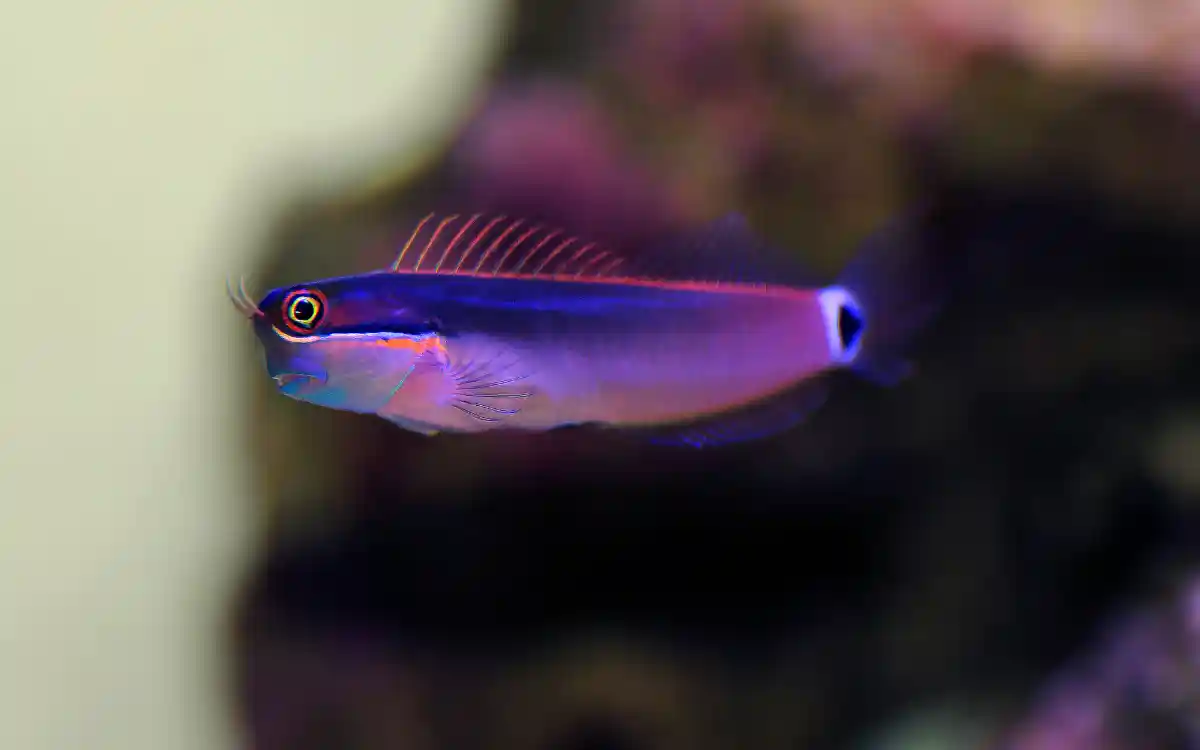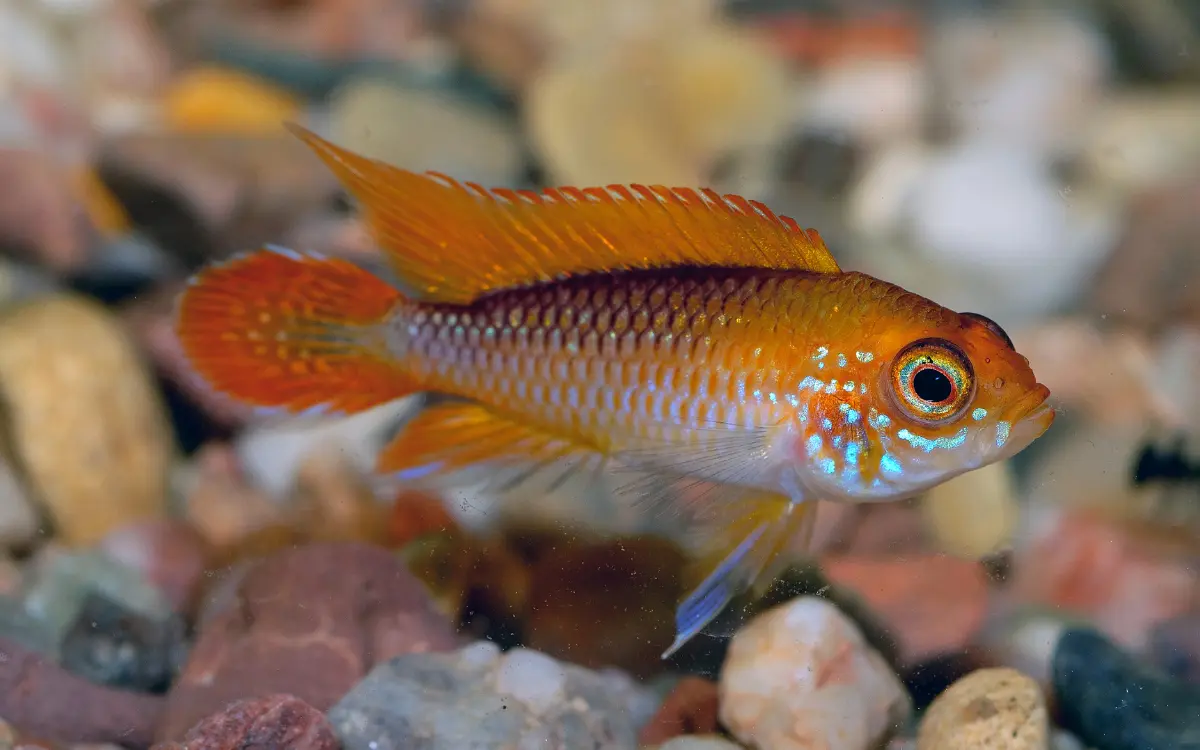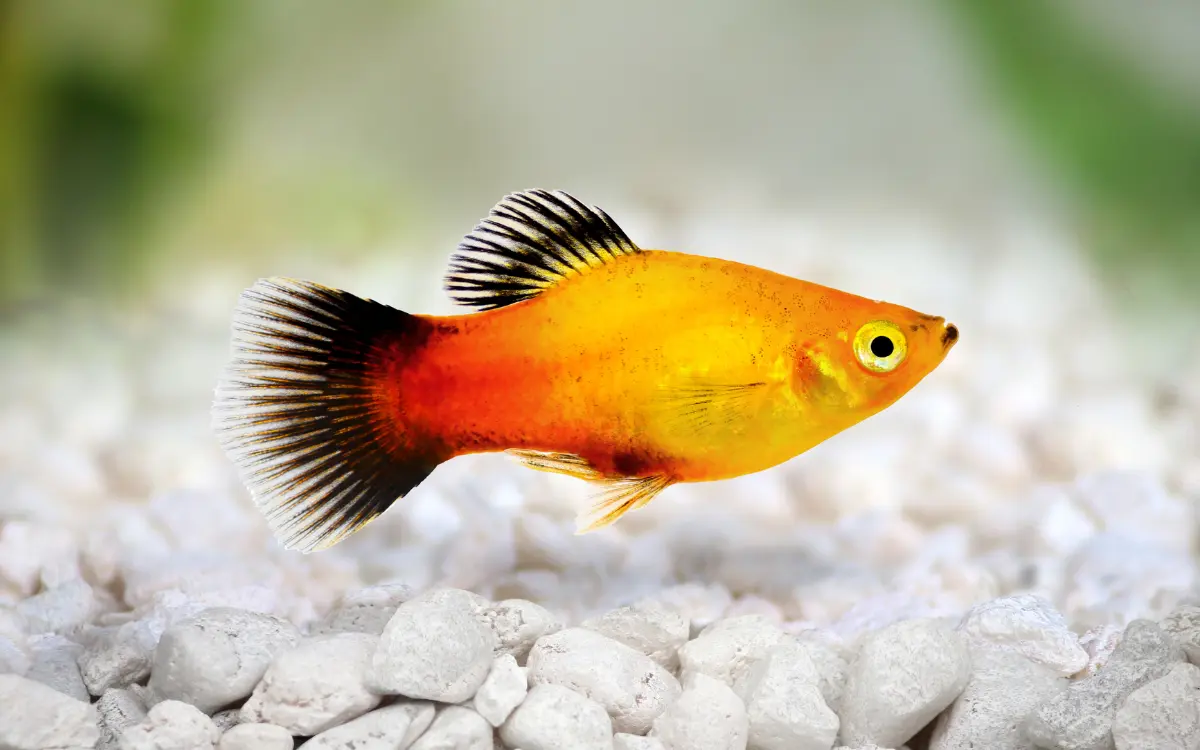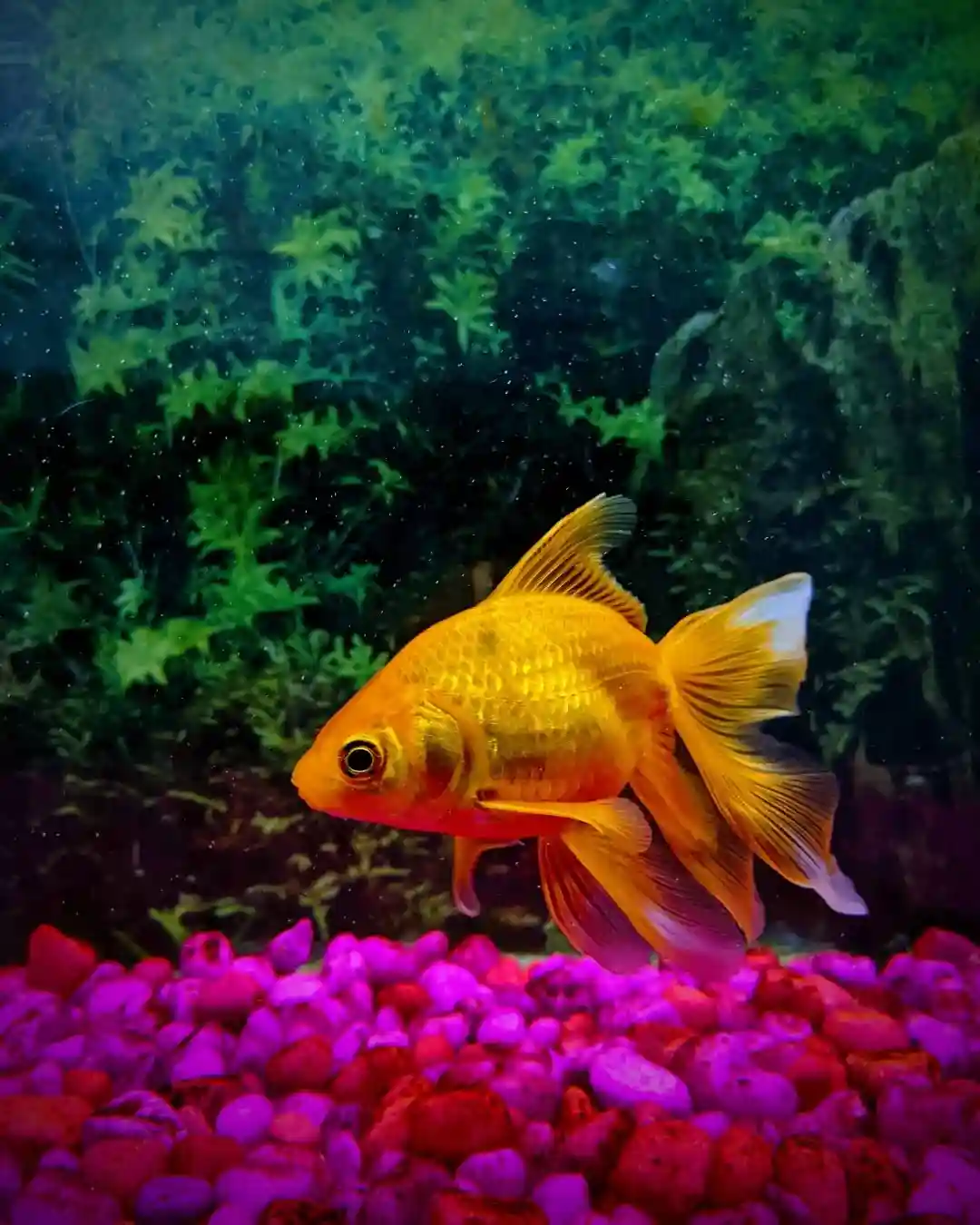20 Types of Butterflyfish: A Complete Guide
The ocean is home to countless beautiful creatures, but few can match the eye-catching charm of butterflyfish. These vibrant, disc-shaped fish bring splashes of color to coral reefs worldwide and have captured the hearts of marine enthusiasts, aquarium hobbyists, and divers alike.
With approximately 120 species spread across 10 genera in the family Chaetodontidae, butterflyfish offer an amazing variety of patterns, colors, and behaviors. In this guide, we’ll explore 20 of the most fascinating types of butterflyfish you might encounter on a reef or want to add to your saltwater aquarium.
What Makes Butterflyfish Special?
Before we jump into our list, let’s look at what makes these fish so unique:
- Distinctive shape: Most butterflyfish have a thin, disc-shaped body that helps them navigate tight spaces between corals.
- Vibrant colors: They display some of the most striking color patterns in the ocean, often featuring bold contrasts of yellow, white, black, and blue.
- Specialized feeding: Many species have long, pointed snouts perfect for reaching into coral crevices for food.
- Pair bonding: Unlike many fish species, many butterflyfish form monogamous pairs that swim together for life.
- Reef indicators: Their presence or absence can signal the health of a coral reef ecosystem.
Now, let’s meet some of the most striking members of this fascinating fish family!
20 Stunning Types of Butterflyfish
1. Heniochus Butterflyfish (Moorish Idol)
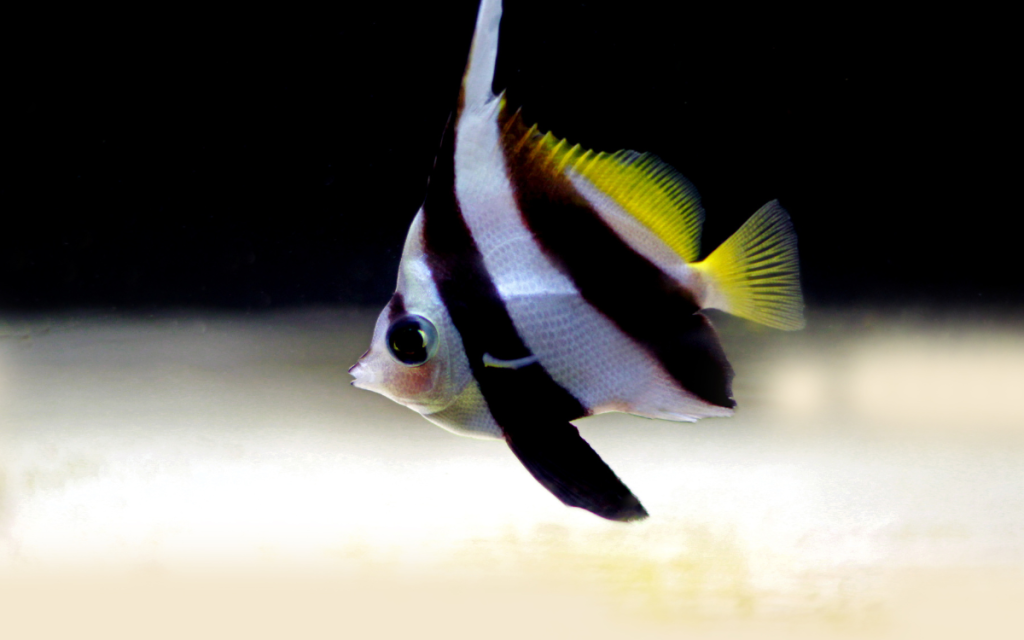
Notable Features:
- Long, flowing white dorsal filament
- Bold black and white vertical stripes
- Grows to about 8 inches (20 cm)
The Heniochus Butterflyfish, also called the Longfin Bannerfish, is one of the most recognizable reef fish. Its striking white pennant-like dorsal filament can be longer than its body, making it appear much larger than it actually is. This fish is often confused with the similar-looking Moorish Idol, though they belong to different families.
These social fish often travel in small groups in the wild but may become territorial in aquarium settings. They’re relatively hardy for butterflyfish, making them one of the better options for dedicated saltwater aquarists.
2. Klein’s Butterflyfish (Sunburst Butterflyfish)
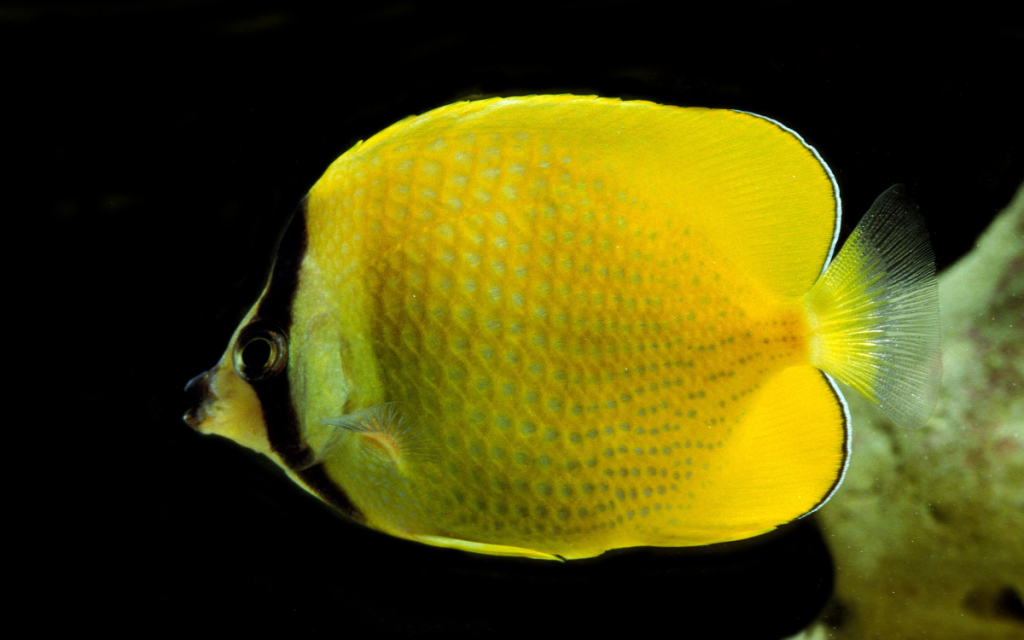
Notable Features:
- Bright yellow-orange body
- Black spot near the tail
- Blue rimming around the spot and fins
Klein’s Butterflyfish brightens up any reef with its sunny yellow-orange coloration. The distinctive black spot near its tail is rimmed with electric blue, creating a “sunburst” effect that gives this fish its common name.
These active swimmers are found throughout the Indo-Pacific region, particularly around Indonesia and the Philippines. They’re mostly coral eaters in the wild, which makes them challenging to keep in home aquariums unless you’re prepared to meet their specialized diet needs.
3. Longnose Butterflyfish

Notable Features:
- Extremely elongated snout
- White body with diagonal yellow stripes
- Black band through the eye
The Longnose Butterflyfish has evolved one of the most specialized feeding adaptations in the reef world. Its exceptionally long snout works like tweezers, allowing it to pluck tiny invertebrates from deep within coral crevices that other fish simply can’t reach.
This specialized feeding behavior makes them incredibly useful on natural reefs but presents challenges for aquarium keeping. Their diet typically consists of coral polyps and small invertebrates, which can be difficult to replicate in captivity.
4. Pyramid Butterflyfish

Notable Features:
- Triangle-shaped white patch on sides
- Yellow primary body color
- Black band through the eye
Named for the distinctive pyramid-shaped white patch on its bright yellow sides, this butterflyfish creates a striking contrast against the blue waters of its reef habitat. The geometric precision of its markings makes it look almost like it was painted by a human artist rather than shaped by nature.
Found primarily in the Western Pacific Ocean, these fish tend to stay close to the reef where they feed on coral polyps and small invertebrates.
5. Tinkeri Butterflyfish
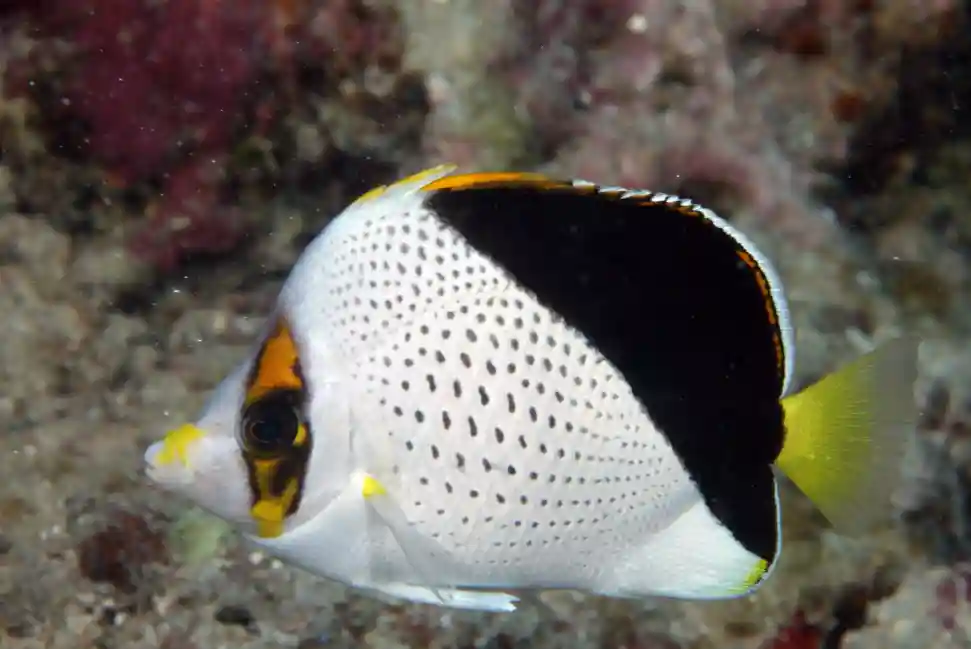
Notable Features:
- Striking black and white body pattern
- Bright yellow dorsal fin
- Limited habitat range
The Tinkeri Butterflyfish is among the most sought-after species for advanced aquarists due to its stunning appearance and relative rarity. With a bold black and white pattern accented by a brilliant yellow dorsal fin, it stands out even among the colorful butterflyfish family.
Native to the waters around Hawaii and Johnston Atoll, these fish aren’t frequently encountered by divers due to their preference for deeper waters, typically below 100 feet (30 meters).
6. Threadfin Butterflyfish
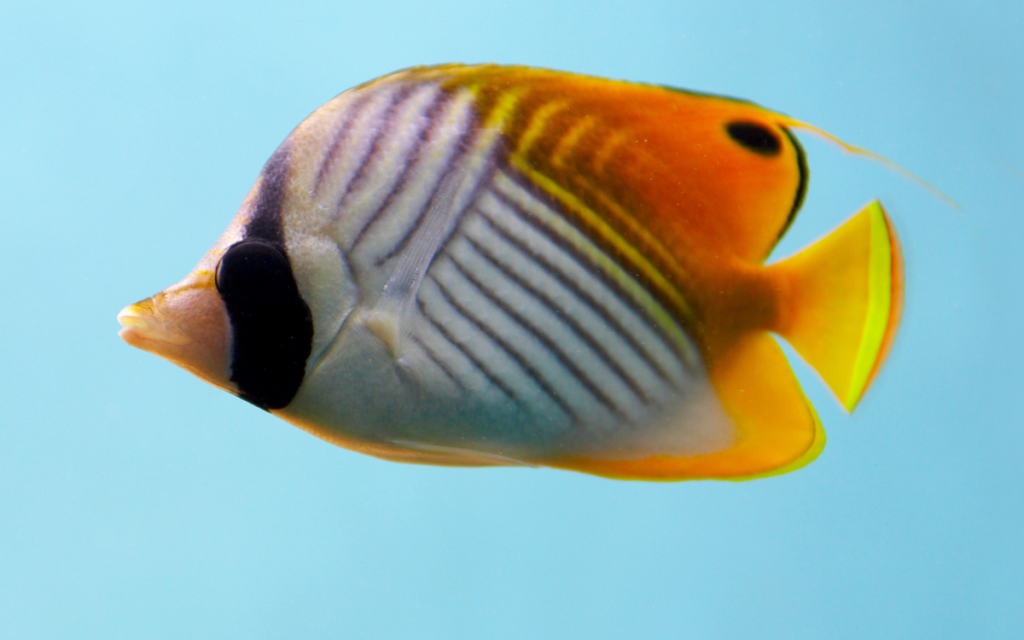
Notable Features:
- Thread-like extension from dorsal fin
- White body with diagonal orange/yellow stripes
- Black spot on rear dorsal fin
The Threadfin Butterflyfish gets its name from the delicate filament that extends from its dorsal fin like a thin piece of thread. This extension can be longer than the fish’s body and adds to its elegant appearance as it glides through the water.
These fish are typically found in pairs in the wild and are known for their peaceful temperament. They mainly feed on coral polyps and anemones, which makes them somewhat challenging to maintain in home aquariums.
7. Raccoon Butterflyfish
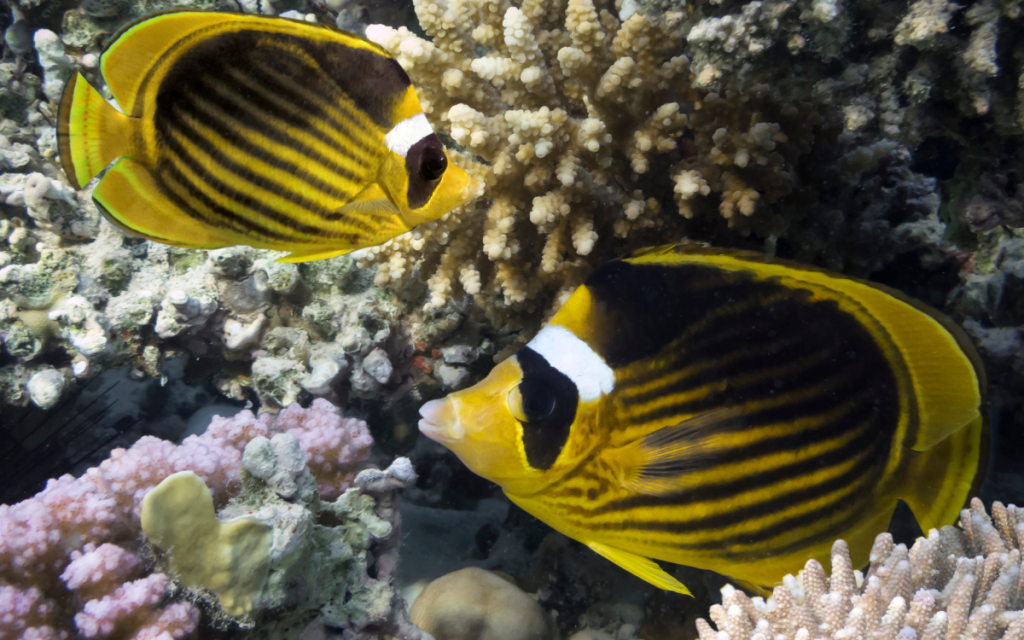
Notable Features:
- Black “mask” across the eyes
- Yellow/white body
- Black spots on rear
Looking like it’s dressed for a masquerade ball, the Raccoon Butterflyfish sports a distinctive black band across its eyes that resembles a raccoon’s mask. This striking feature makes it instantly recognizable on the reef.
Common throughout the Indo-Pacific, these active swimmers often form pairs and defend small territories. They’re more adaptable to aquarium life than many other butterflyfish species and will sometimes accept prepared foods, making them a good choice for fish enthusiasts looking to keep their first butterflyfish.
8. Sunset Butterflyfish (Pelewensis Butterflyfish)
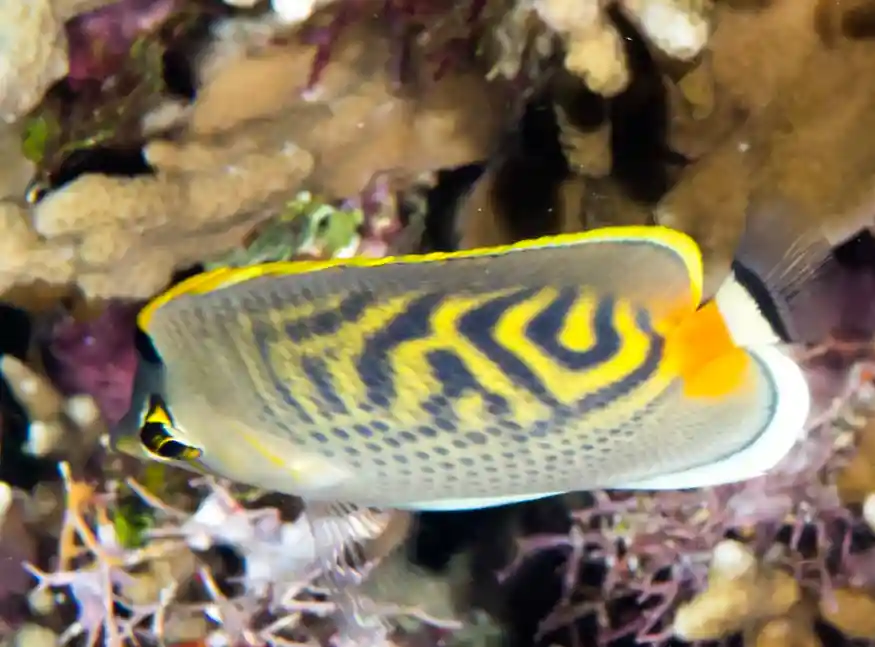
Notable Features:
- Yellow body that darkens toward the rear
- Blue vertical lines
- Black edges on fins
The Sunset Butterflyfish lives up to its name with a gorgeous yellow body that appears to darken toward the tail, creating a sunset-like gradient effect. This coloration is enhanced by delicate blue vertical lines that run down its sides.
Native to the western Pacific Ocean, particularly around Micronesia, these fish are reef-associated and usually found swimming in pairs. They primarily feed on coral polyps and small invertebrates.
9. Spotfin Butterflyfish

Notable Features:
- Black spot on dorsal fin
- Yellow body
- Curved back profile
The Spotfin Butterflyfish is named for the prominent black spot on its dorsal fin, which stands out against its otherwise bright yellow body. This marking may serve as a fake “eye” to confuse predators about which end of the fish is which.
These active fish are found throughout the Caribbean and western Atlantic Ocean, where they feed mainly on coral polyps, tube worms, and small invertebrates. They’re known for their curious nature and will often approach divers.
10. Pakistan Butterflyfish (Redtail Butterflyfish)
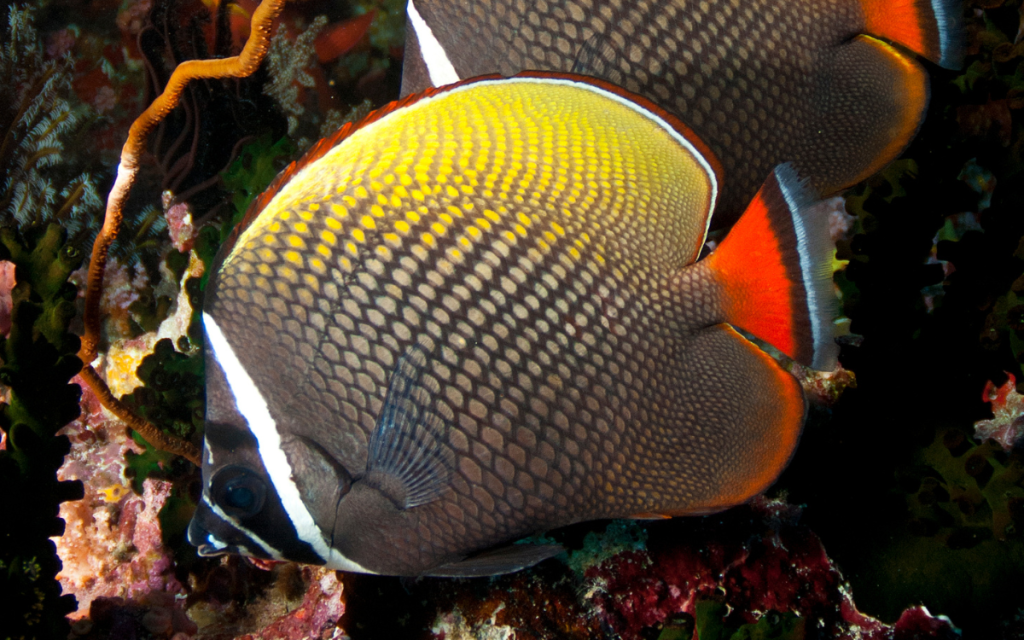
Notable Features:
- Reddish tail
- Dark band across face
- Yellow-white body with fine vertical lines
The Pakistan Butterflyfish, despite its name, is actually found throughout the Indian Ocean and Red Sea rather than specifically in Pakistan. Its most distinctive feature is its reddish tail section, which contrasts beautifully with its lighter body.
These fish typically form mated pairs that stay together for life, defending a small territory on the reef. Their diet consists mainly of coral polyps and small invertebrates.
11. Mitratus Butterflyfish
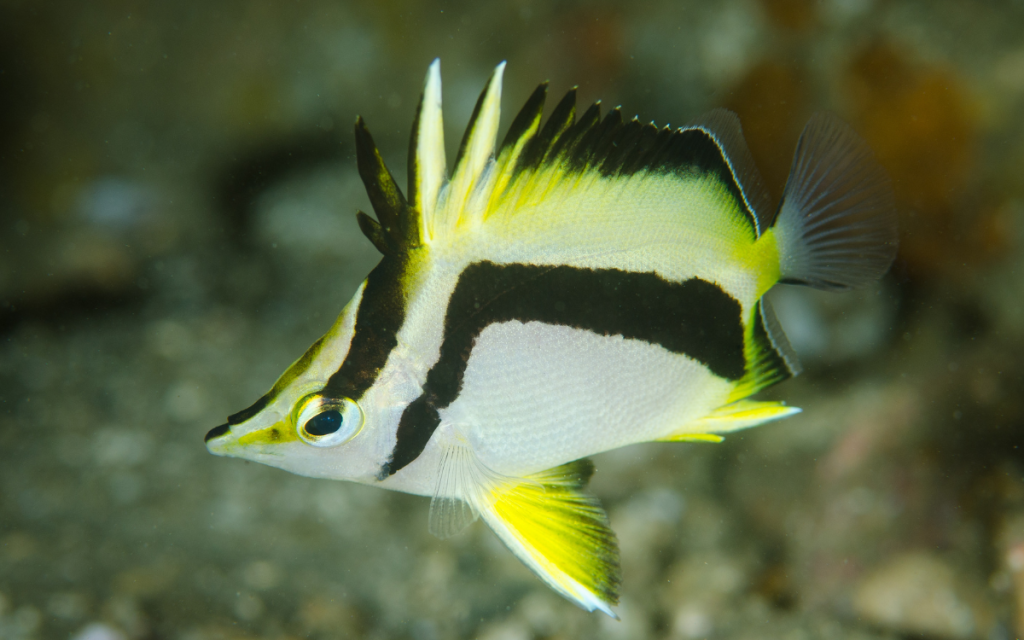
Notable Features:
- Yellow body
- Bold black diagonal stripes
- Rounded profile
The Mitratus Butterflyfish creates a striking visual impact with its sunny yellow body crossed by bold black diagonal stripes. The contrast makes it highly visible on the reef, where it often swims in pairs.
Found in the eastern Pacific Ocean, particularly around the Galapagos Islands, these fish are known for their territorial nature. They primarily feed on coral polyps and small crustaceans.
12. Copperband Butterflyfish
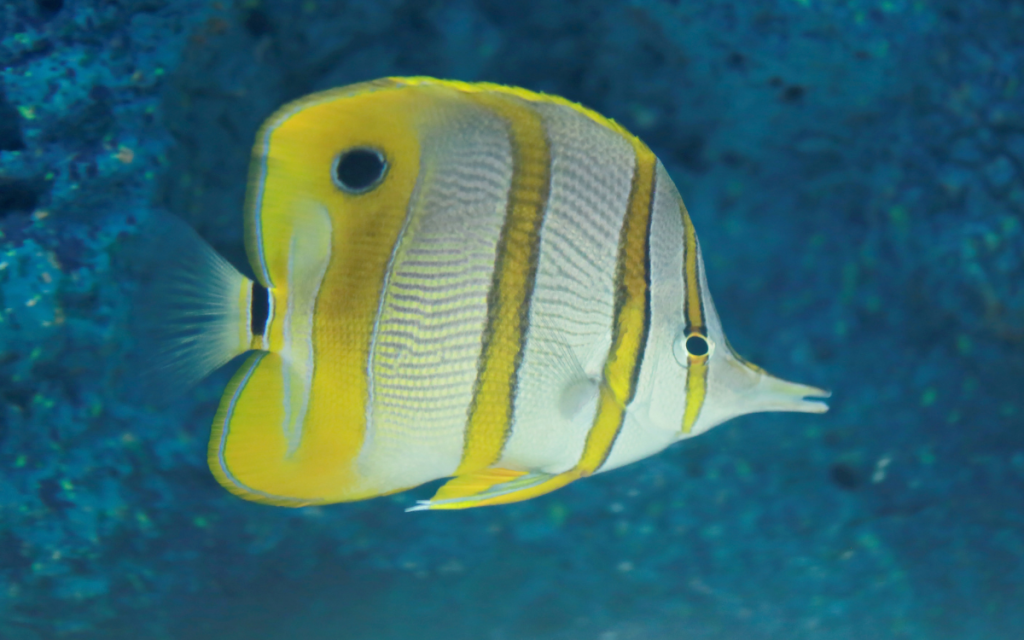
Notable Features:
- Vertical copper-orange bands
- Long, pointed snout
- White/silver base color
The Copperband Butterflyfish is one of the more distinctive members of the family, with bold vertical orange bands that run down its white body. Its extremely long, pointed snout is specialized for reaching deep into coral crevices to extract small invertebrates.
This species is popular in the aquarium trade not just for its beauty but also for its useful habit of eating Aiptasia, a pest anemone that can overrun reef tanks. However, they can be finicky eaters in captivity and require patient acclimation.
Read also: 11 Types of Tang Fish (With Colors, Care & Tank Tips)
13. Golden Butterflyfish (Bluecheek Butterflyfish)

Notable Features:
- Bright yellow body
- Blue patch near eyes
- Black marking on tail
The Golden Butterflyfish lives up to its name with a brilliant yellow body that seems to glow against the blue background of the ocean. The distinctive blue patch near its eyes gives it its alternate name, the Bluecheek Butterflyfish.
Found throughout the Indian Ocean and western Pacific, these fish are usually seen in pairs that remain loyal to each other for life. They primarily feed on coral polyps and small invertebrates hiding within the reef structure.
14. Black Back Butterflyfish
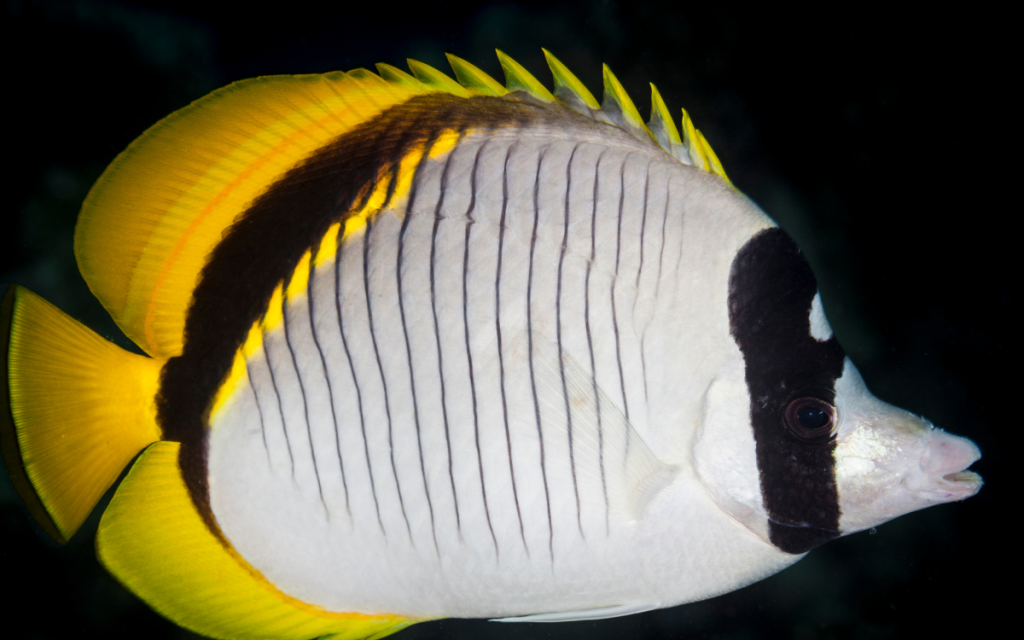
Notable Features:
- Dark patch covering back portion
- Yellow and white body coloration
- Small size compared to other butterflyfish
The Black Back Butterflyfish features a distinctive dark patch that covers most of its back, creating a striking contrast with the yellow and white coloration on the rest of its body. This pattern helps break up its outline when viewed from above, providing some camouflage from predators.
These fish are typically found in the waters of the Indo-Pacific region, where they forage among coral reefs for small invertebrates and coral polyps. They’re generally seen swimming in pairs.
15. Falcula Butterflyfish (Blackwedged Butterflyfish)
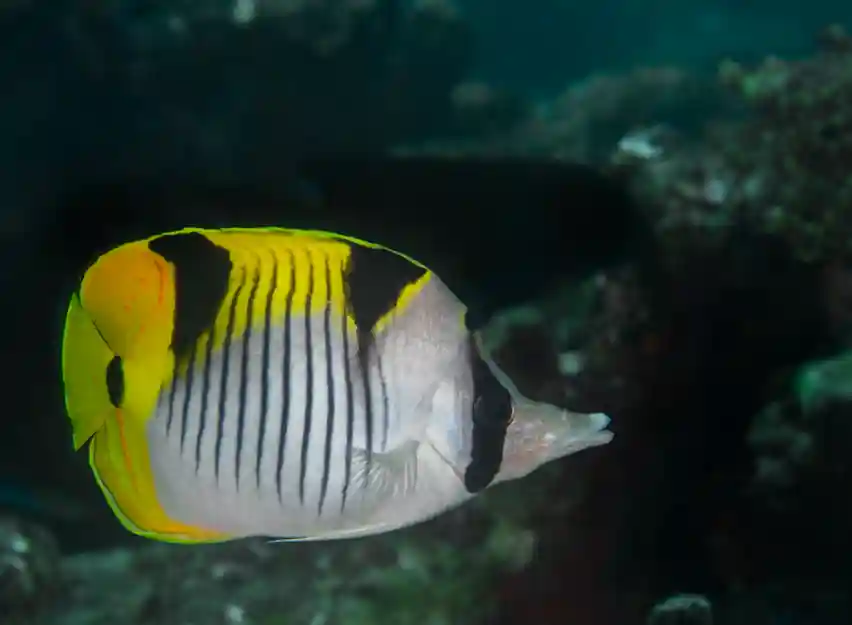
Notable Features:
- White body
- Black triangular patches on sides
- Yellow accents on fins
The Falcula Butterflyfish, or Blackwedged Butterflyfish, sports distinctive triangular black patches on its white body that create a geometric pattern unlike any other fish on the reef. These wedge-shaped markings give the fish its scientific and common names.
Native to the waters of the western Pacific Ocean, these fish form monogamous pairs that defend small territories. They primarily feed on coral polyps and are challenging to keep in aquariums due to their specialized diet.
16. Orange Margin Butterflyfish
Notable Features:
- Orange margins on dorsal and anal fins
- White body with black markings
- Yellow highlights
The Orange Margin Butterflyfish gets its name from the bright orange edges that run along its dorsal and anal fins, creating a fiery outline against its primarily white body. This colorful border makes it stand out even in the vibrant environment of the coral reef.
Found in the western Pacific Ocean, these fish typically swim in pairs and feed on coral polyps and small invertebrates. They’re known for their peaceful temperament but require excellent water quality when kept in aquariums.
17. Bank’s Butterflyfish
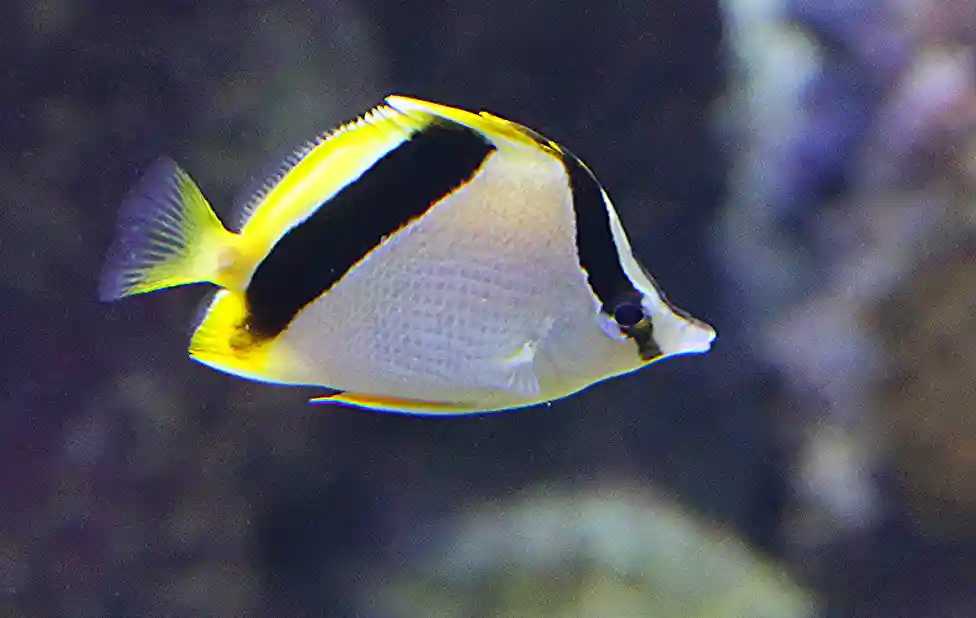
Notable Features:
- White body
- Yellow fins
- Black spot near tail
Bank’s Butterflyfish presents a clean, elegant appearance with its white body contrasted by bright yellow fins. The black spot near its tail may serve as a false “eye” to confuse predators about which direction the fish will flee if threatened.
These fish are found throughout the Indo-Pacific region, where they form monogamous pairs that stay together for life. They feed primarily on coral polyps, which makes them challenging but not impossible to keep in well-established reef aquariums.
18. Banded Butterflyfish
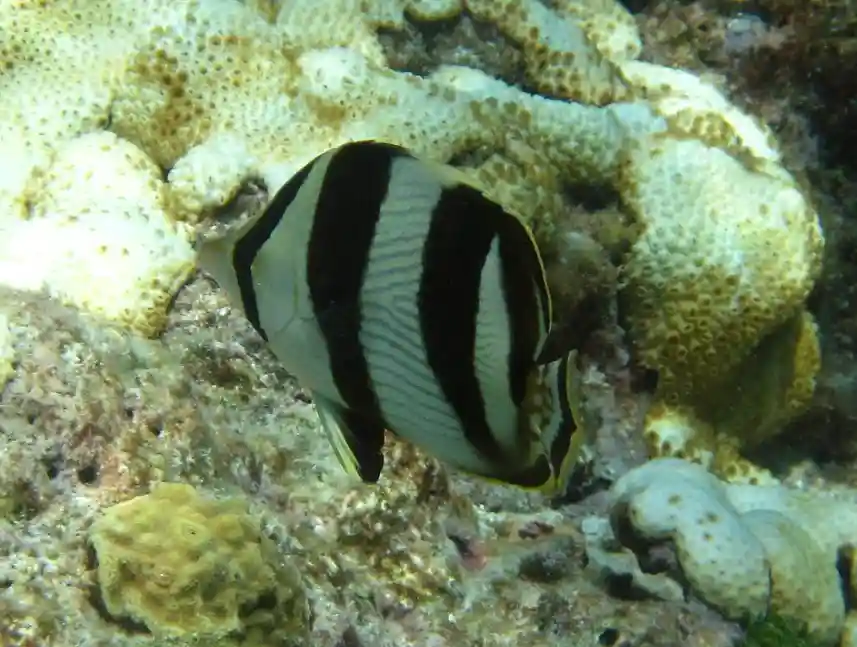
Notable Features:
- Bold black vertical bands
- White base color
- Yellow accents on fins
The Banded Butterflyfish features a striking pattern of black vertical bands against a white body, creating a zebra-like effect that’s instantly recognizable. These bold markings help break up the fish’s outline, providing some camouflage against the complex visual background of the reef.
Common in the Caribbean and western Atlantic Ocean, these fish are often seen swimming in pairs. They’re among the hardier butterflyfish species and will sometimes accept prepared foods in aquariums, making them a good choice for experienced marine aquarists.
19. Double Saddle Butterflyfish
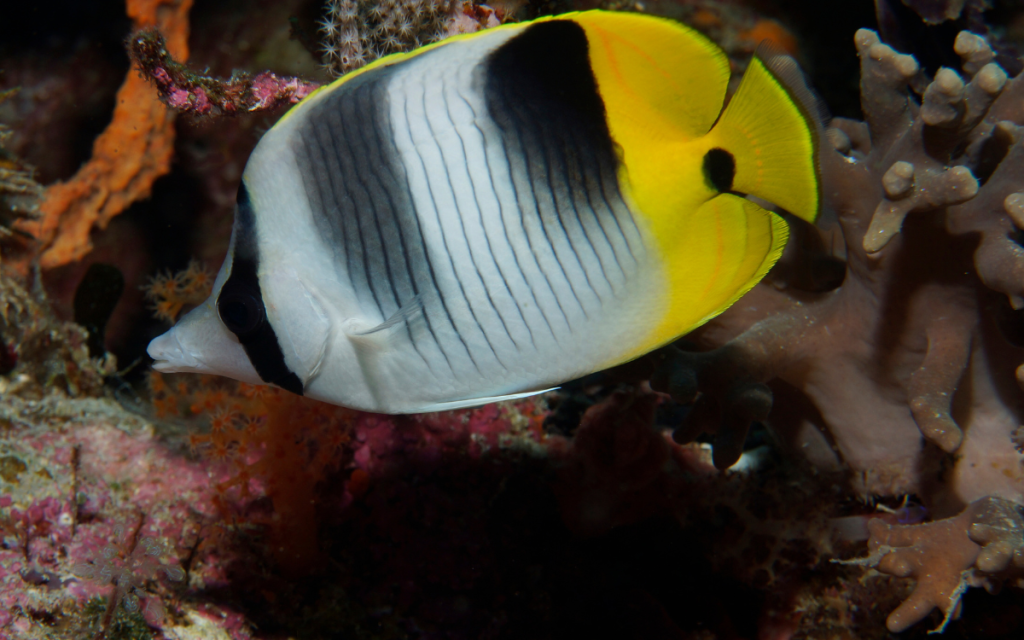
Notable Features:
- Two distinct black “saddles” across back
- Yellow body
- Black face band
True to its name, the Double Saddle Butterflyfish displays two prominent black markings across its back that resemble saddles. These bold markings stand out against its bright yellow body, making it easy to identify on the reef.
Found primarily in the Indo-Pacific region, these fish are often seen in pairs or small groups. They feed mainly on coral polyps and small invertebrates, using their pointed snouts to reach into tight crevices in the reef structure.
20.Arabian Butterflyfish (Red Sea Butterflyfish)
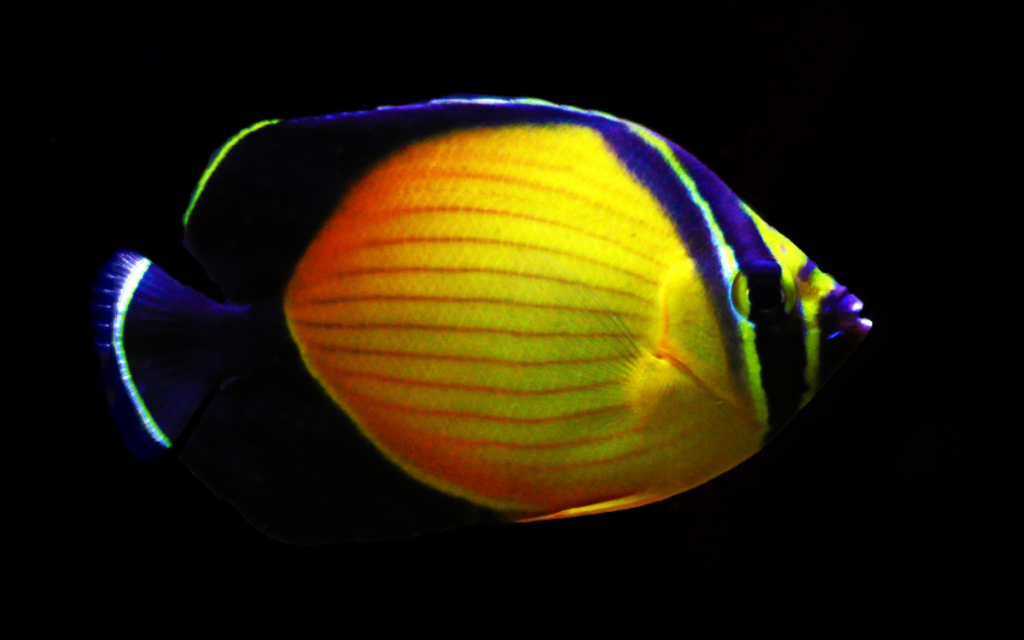
Notable Features:
- Bright yellow body
- Blue horizontal lines
- Black spot near tail
- White facial band
The Arabian Butterflyfish lights up reefs throughout the Red Sea and Arabian Gulf with its sunny yellow coloration and electric blue stripes. The black spot near its tail likely confuses predators by mimicking an eye.
These social fish almost always swim in pairs, forming lasting bonds with their mates. They reach about 5-6 inches in length and prefer coral-rich areas where they feed on polyps and small invertebrates.
In aquariums, they need large tanks (125+ gallons) with plenty of hiding spots and excellent water quality. Their specialized diet makes them best suited for experienced marine hobbyists who can provide varied food options.
With their striking appearance and graceful swimming style, Arabian Butterflyfish bring a splash of Red Sea beauty to any setting they inhabit.

